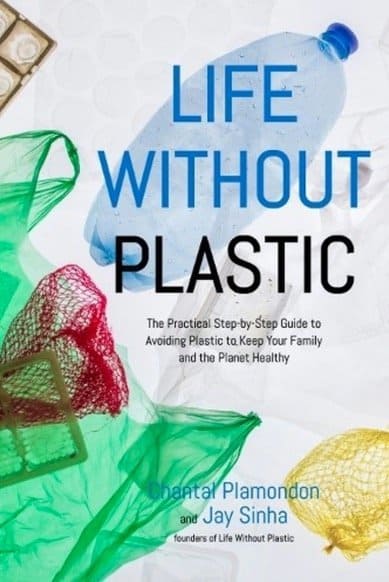Quick Links
During our travels, I’ve noticed that many items in zero-waste shops are being replaced with silicone products. I have seen friends making cupcakes in silicone trays, which made me cringe. But is silicone safe for food, or should we stay away from it?
Oh, the stasher bags (silicone bags) that look like a great alternative to zip-lock bags, but are they really? Also, not all silicone products are made the same; by that, I mean some add fillers, making them lower-quality silicone.
During our meeting with the team from LifewithoutPlastic, we discovered that silicone isn’t as environmentally friendly as we thought. However, the most intriguing aspect might be the sustainable, long-lasting nature of products, which aligns well with the zero-waste lifestyle.
You can get a copy of their new book if you want to learn more about silicone and plastic-free living. It certainly has become my go-to book for anything plastic-related.

The Benefits of Silicone Products
- Kitchenware: Many cooking and baking utensils are made from silicone, including spatulas, tongs, baking mats, cake molds, and ice cube trays. Silicone is also used in pot holders, lids, and seals for food storage containers.
- Personal Care Products: Silicone is commonly found in cosmetics, hair products, and skincare items, where it contributes to a product’s spreadability and smoothness. It’s often used in deodorants, lotions, sunscreens, and a wide range of makeup products. (Check out our zero waste deodorants article to find a better alternative)
- Electronics: Silicone is used in various electronics for its insulating properties. It can be found in keypads, cases, gaskets, cables, and seals.
- Medical Devices: Due to its biocompatibility and flexibility, silicone is used in a range of medical devices, including catheters, tubing, seals, and various implants.
- Construction Materials: In construction, silicone is used in sealants, adhesives, and coatings due to its durability and resistance to weathering.
- Automotive Parts: Silicone is used in various parts of vehicles, including gaskets, seals, hoses, and lubricants.
- Clothing and Textiles: Silicone can be found in swim caps, water-resistant clothing, and even in some undergarments for its smooth and flexible properties.
- Baby Products: Many baby products, like bottle nipples, pacifiers, and teething toys, are made from silicone.
- Home Goods: Silicone is used in a variety of home goods, such as furniture polish, water-repellent fabric treatments, and even in some types of carpeting.

The Cons of Silicone
- Higher cost: Silicone products are often more expensive than alternative materials, making them less economically feasible for certain applications.
- Lower tear strength: While silicone is flexible, it can have lower tear strength compared to other materials, making it more susceptible to damage in certain high-stress situations.
- Less elasticity: Silicone may not have the same level of elasticity as some other materials, which can limit its suitability for industrial machines and applications where extreme stretchability is required.
- Potential for leaching: In some cases, silicone products, particularly those of lower quality, may leach small amounts of certain substances over time, which can be a concern for sensitive applications such as medical devices or food contact.
- Longer curing time: Silicone-based materials often require a longer curing or drying time compared to other materials, which can impact manufacturing timelines and efficiency.
- Adhesion challenges: Silicone can be difficult to bond or adhere to other materials, which may require additional steps or specialized adhesives for proper bonding.
- Environmental impact: While silicone is generally considered safe for use, its production involves the use of certain chemicals, and the disposal of silicone products can contribute to environmental waste.
Remember, not all silicone is created equal. For items that will come into contact with food or the body, look for food-grade or medical-grade silicone products.
At the end of this article, I will give you some easy tricks to determine whether your silicone product is safe or not.
What is silicone made of?
The only thing I knew about silicone was that it is made from sand, and I never really questioned it any further. It is natural, so it must be recyclable. You have probably heard that, too, right?
Well turns out that isn’t quite the case.
Silicone is like any plastic polymer, synthetic. That means it includes a mix of chemicals derived from fossil fuels.
When we say silicone is made from sand, we are not wrong. Silica- or silicon dioxide – is actually what we are referring to.
- Silica is the raw material used to make silicone resins. Beach sand is practically pure silica.
- Silicon is the base material made by heating silica at very high temperatures with carbon in a furnace.
- Silicone is then reacted with fossil fuel-derived hydrocarbons to create siloxane monomers bonded together into polymers to form the final silicone resin.
Is Silicone toxic to humans?
It is not a 100% natural material, unlike rubber. Nonetheless, silicone is considered to have no known health hazards, according to Health Canada. It can also withstand extreme heating and freezing temperatures without leaching or off-gassing hazardous chemicals – unlike plastics, which contaminate food when in contact with high temperatures.
While the research indicates that silicones are certainly very stable, in the book of LifeWithOutPlastic, I have come across one study that suggests that several siloxanes were detected after 72-hour exposure to alcohol.
Siloxanes are considered endocrine disruptors, and some have been linked to cancerous tumors, congenital disabilities, and other developmental disorders. [1]
Is it safe for cooking?
Well, this is a difficult question to answer. As I said, it is pretty tough and can resist high heat and freezing without much leaching. Would I use it for my daily cooking? Personally, no! I wouldn’t say I like how it feels in my hands, and I rather stick with the steel option. Or I use spoons and stirrers from wood rather than silicone ones.
But that is a personal preference.
There are also ceramic and stainless steel options for most baking and cooking. While it is a safer alternative than Teflon or another non-stick coating with perfluorinated chemicals, I would only use it if there is no other choice.
Related: Can my non-stick pan be the cause of my illness?
Silicone oven mitts and spatulas, splatter guards, and pot holders are only in contact with food for a minimal amount of time. But, we prefer to avoid them for direct food contact.
Is it safe for my child?
I have to start asking myself those questions since our baby is only a couple of months away from being welcome into this world. I am chasing down the natural rubber latex pacifier or bottle with silicone nipples made from latex.
Don’t put them in the washer; they wear out quicker.
Another tip: When buying items made from silicone, ensure they are medical-grade or at least food-grade materials. One way to test this is by poking and twisting the silicone product and observing if there is a discoloration happening? If the silicone turns white, it has been mixed with fillers, which is not safe to use.
Pure silicone does not change color.
Is silicone recyclable?
Municipal curbside recycling programs rarely pick up silicone. Very few companies collect recycled silicone, take it and down-cycle it into lubricant for machines.
This is probably the biggest reason why I will not buy silicone items. I don’t want to be the guy that puts another product for thousands of years into our landfills.
We know silicone is durable and an excellent alternative to single-use plastics, but can we recycle it as we do with paper, glass, or plastic?
The short answer? It’s complicated. Silicone doesn’t degrade or process like other recyclable materials, which means it’s not suitable for your regular recycling bin.
But don’t lose hope! There are specialized recycling programs like TerraCycle, which have collaborated with companies to recycle silicone products. For example, their Stasher Bag Recycle Program is a fantastic initiative for recycling silicone food storage bags.
Some manufacturers are also making strides, offering to reclaim and recycle old silicone products. So while silicone recycling isn’t as simple as we’d like, it’s not impossible.
The best practice, as always, is to use your items for as long as possible, then repurpose, donate, or find a specialty recycling program.
I hope this article could answer some of your questions in regard to silicone. If I didn’t answer yours or have some burning questions, please leave them in the comments below.

https://waterfallmagazine.com
Helpful information. Fortunate me I found your website by
accident, and I am surprised why this twist of fate didn’t came
about earlier! I bookmarked it.
I am glad to hear that.